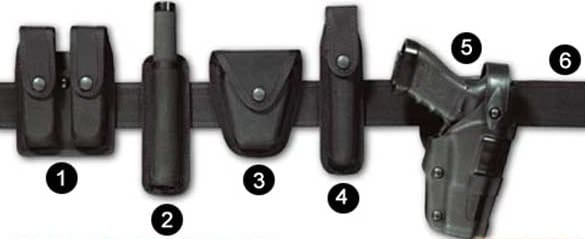The following article was written by Ben Kurata, Senior Staff Instructor at Texas’ International Training, Inc. We republish it here with the permission of the article’s sponsor, Action Targets
Recently, a transit Officer was convicted of homicide after he shot an individual to death while attempting to control the subject’s behavior. According to the Officer’s testimony, he thought he was reaching for his Taser but discharged his duty firearm instead, killing the subject. Now, I am not here to pass judgment on the Officer’s actions, as I was not there. But for some time, I have recommended that Tasers be mounted on the duty belt on the non-dominant side, with the grip pointed backward, NOT in a cross-draw position. Why? Well . . .
Over the course of his / her career, a LEO may pull their handgun from its holster hundreds, maybe thousands of times during in-service training and qualification. A LE Trainer may pull a handgun from its holster tens of thousands of times.
Question: How many times does an average LEO pull a Taser from its holster and discharge it? In most departments that I have trained with, after initial training (with its “special” videotaped moments), the only time a Taser gets pulled from its holster is when it is used on a subject. I know of no in-service or qualification live fire course of fire for the Taser.
What’s the point?
Many years ago, someone much wiser than I will ever be said: “Under stress, you will revert to what you do most often or most recently.”
I only wish I could remember who told me that so I could give them credit. The point is, the dominant hand has been conditioned by hundreds (if not thousands) of repetitions to access and fire the handgun, not the Taser.
Similarly, I wish I could have a dollar for every time I saw on the range a cell phone or pager get pulled from the belt and forcibly stuffed into the magazine well of a weapon. Why? Because the operator was reverting back to the location and object on his / her duty belt that (s)he accesses most often in the course of a day – dozens of times.
Many years ago, fellow Action Target Instructor Dennis Tueller established the 21 foot guideline which has been misinterpreted over the years as the “21 foot rule”. While not diminishing the validity of what Dennis established, I can say that for the average LE Instructor (who, in theory, should be smoother and quicker at presenting the duty handgun from the duty holster) the average reactionary gap when wearing a Level II or Level III retention holster is more like 40 – 60 feet.
That is with the outcome pre-determined – draw the handgun and place one or two well-placed shots on an inert practice target. Under the stress of a life -threatening attack, reaction time can double, quadruple, or deteriorate even more. Why? Well, some definitions may be useful:
Reaction Time:
“Reaction time has sometimes been described as a function of Hick’s law:
(1) H = log2(n + 1).
(2) H = ? pi log2(1/pi + 1).
H = the information-theoretic entropy of a decision.
n = the number of equally probable alternatives.
pi = the probability of alternative i for n alternatives of unequal probability.
The time it takes to make a decision is roughly proportional to H, the entropy of the decision (the log of the number of alternatives), i.e. T = k H, where k ~ 150 msec” 1
I have no idea what that means, but it may be useful in calculating the probability of getting a raise or the budget you submitted. “Entropy of the decision” is the scientific way of saying “brain cramp”! What is important to note is that formula was established by test subjects that were not being presented with life-threatening stimuli, and under ideal conditions, reaction time is a logarithmic, (12, 22, 32, etc.) not an arithmetic (1 + 1, 2 + 1, etc.) variable.
How many use of force options does the average Officer have?
1. Presence;
2. Verbal instructions / commands;
3. Empty hand techniques;
4. Aerosol spray;
5. Baton;
6. Taser;
7. Radio;
8. Lethal force, which can include:
1. Handgun;
2. Folding knife;
3. Baton, if targeted on “red” areas of the anatomy;
4. Shotgun;
5. Patrol Rifle;
6. Improvised weapons (“Bumper – 06”);
7. Etc.
And, let us not forget that word that has been pounded into every Officer’s head (and we have to share the responsibility for this one): Liability.
Now, let’s add the one factor that throws almost all probability theory out the window: Life – threatening stimuli.
A concept which may be more useful in understanding actual reaction time under life – threatening circumstances may be USAF Lt. Col. (Ret.) John Boyd’s OODA loop. It is not my intention here to recap my understanding of the OODA loop. (For an excellent summary, please locate and read Ken Good’s article, “Got a Second? Boyd’s OODA Cycle in the Close Quarter Battle Environment”.)
Suffice it to say that after being in and running a few force-on-force simulations, most people (including myself) make mistakes in the initial Observation phase and then get caught in what Ken Murray describes as a “goofy loop” 2 – unable to make an appropriate decision as to what to do next. Or, caught on the reaction (wrong) side of the action / reaction curve.
So What?
Well, let me just throw this out for thought:
- All less lethal tools (including radio, pager, and cell phone) on the non – dominant side of the duty belt / LBE, etc., accessed and practiced with the non-dominant hand.
- All lethal force tools on the dominant side of the duty belt, accessed and practiced with the dominant hand.
Now, please don’t misinterpret me. I am not saying to stop practicing wounded / disabled drills. Now, more than ever, I practice accessing, shooting, reloading, and clearing stoppages with the non – dominant hand AND EYE only. It all boils down to, “Under stress, you will revert to what you do most often or most recently.”
Notes:
- http://www.usabilityfirst.com/glossary/hicks-law/
- Kenneth R. Murray, “Training at the Speed of Life, Volume 1”, copyright Armiger Publications, 2004.





This article makes a lot of good sense.
I don’t think the officer who pulled his handgun instead of his taser is 100% culpable. His agency that let him wear his taser on the wrong side as did not provide proper training shares in the guilt. Although tragic, this kind of “accident” happens often.
I also wear my lethal tools on my strong side (firearm/knife) and non lethal on my support (pepper spray/magazines, light) for the same reason. This holds for my street carry and my duty belt.
In terms of what you will do under stress, I offer an expanded comment:
“Under stress, you will NOT rise to the occasion. Your skills will NOT get better as needed, you skills WILL degrade. Some instructors state that under stress you do as you are trained. That is not quite true. Under stress you will do what your most ingrained training tells you to. If you have been doing “x” for 2000 repetitions, and “y” f0r 5oo repetitions, you will do “x” under stress until such time as “y” over takes “x” in ingrained training.”
All the junk — yes, junk — hanging off a duty belt has added a layer of complexity that even a well-trained LEO cannot master. Look at the illustration. Most LEOs carry even more stuff than what’s shown. Do LEOs need more training, or maybe more focused training on a simplified manual of arms?
The author should get together with someone who understands the mathematics. His illustration of “logarithmic” versus “arithmetic” is incorrect. (Neither series is illustrative of a logarithmic function (both can be fit by linear functions: y=mx+b), and it appears the author may have confused “logarithmic” with “exponential”.
As an illustration of the application of the supplied functions, let’s “do the math” for n=4 and n=8.
n=4: log2(4+1)=~2.32
n=8: log2(8+1)=~3.17
So H(8)/H(4) =~ 1.37 [The ratio of the 8-item case to the 4-item case)
So, if Hick’s law is correct, then the “decision entropy” for an 8-item belt is approximately 37% greater than for a 4-item belt. Applying the T=kH conversion (where k=150mSec)
n=4: 348 mSec
n=8: 475 mSec
Note that H(1) = 1. That means that (assuming Hick’s law is correct) the guy who only has one item on his belt should be 3 times “faster” (1/3 the decision entropy) of someone who has 4 items. This would suggest that Hick’s law is incorrect for a single item since the time to “decide” which item to use when there’s only one choice should be zero. Picture a fast-draw artist with nothing on his hip but his gun. The time it takes for him to decide “which” gun to use is essentially zero. Ed McGivern was reputed to be able to draw and fire 5 times in 0.4 seconds. It would seem odd if he actually wasted .150 seconds (more than a third of the time) deciding “which gun” to use.
Delving a little deeper, Hick’s seems to rely upon an assumption that humans make this sort of selection using a binary search – which would explain why log-base2 is used. This would seem to imply sequential processing. While this may be a useful approximation when one BEGINS to learn tool selection, it seems unlikely that one who has practiced sufficiently would encounter the same limitation (less “brain cramp”). Why? Because the brain is not a strictly sequential processor. In fact, it does many functions in parallel. The effect of practice would appear to convert the binary-search into the information systems equivalent of a hash lookup. That is, there is little or no “decision entropy” involved.
Think of a kid playing video games. They may have a dozen different buttons on a controller. When they first begin to play, it takes a relatively long time to figure out which button to push at a given time. This is the analogue of a typical poorly-practiced cop trying to select from one of a dozen items on his belt. After a time, the selection of the right button to push becomes reflexive. The decision loop tends to eliminate the “selection of item” portion of the process and almost “hardwire” the stimulus to the choice of response.
The second Hick’s Law equation is incomplete (or simply wrong?). Perhaps it explains the effect of training. (It appears to address the issue of probability of selection, which if known ahead of time would certainly affect the decision cycle, but the current form of the equation cannot be correct.)
“The author should get together with someone who understands the mathematics. His illustration of “logarithmic” versus “arithmetic” is incorrect.”
Is the Massachusetts Institute of Technology good enough? My original article had the correct logarithmic annotations, it’s just that my article has been cut and pasted so many times to a plain text clipboard then to re-format into a HTML or XML web author program that 2 squared and 3 cubed became what you see above. Perhaps you should get together with someone who knows about what happens to character set encoding when the original Word doc has been cut and pasted exponentially.
I really don’t give squat about Hick’s law, or any other “law” that attempts to predict human behavior under stress, hence my comments about its usefulness in predicting your next raise or your next budget being approved. I find it amusing that so-called “experts” who have never had anything more stressful than the wrong latte handed to them at Starupchucks cite “Hick’s Law” in an attempt to explain how “optimal” human performance under stress should be.
If you dwell on the mathematical “errors”, then you aren’t in the audience the article was intended for – the people George Orwell referred to that allow mathematicians (and others) to sleep well in their beds at night. You might want to check the quote yourself – my paraphrasing obviously has grammatical and syntax errors not thought of yet, even by the Dutch government.
Sorry, I don’t buy the “I couldn’t tell I was shooting the suspect with my pistol instead of my taser” defense. Tasers take the threat down. Pistols take the threat down and out, if the defender does their job properly.
The problem with the involved officer was selection and training. Under stress, the officer grabbed the wrong device, in a hurry, and took another’s life and the defense is, oops… Either that, or the officer meant to shoot the suspect with his sidearm. Negligent homicide as opposed to premeditated murder or approximations thereof.
You select the officer, using judgment, decision making and values (human life) as a primary criteria, then you stress train them and evaluate their performance. Anything that remains uncorrectable, bounces them. I have never served with anyone so trained, who would have made this error.
With respect to taser placement, non-dominant grip to the rear. You are making a choice between lethal and non-lethal (mostly) force. Placement of the taser, non-dominant grip to the front facilitates it’s deployment, it’s faster, the device is out of the way and still rapidly accessible. Deployment requires decision making and judgment and after that nothing should imped the action selected, or the officer’s life is endangered.
Selection and training are where the rubber meets the road. If the officer cannot be trained to perform at the levels required, which are not excessive, they should not be placed in service. Selection based upon judgment, decision making and the valuation of human life come in large part, preprogrammed into the individual.
Comments are closed.